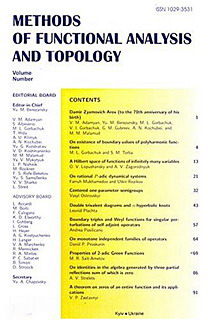S. Maksymenko
orcid.org/0000-0002-0062-5188
Search this author in Google Scholar
Foliations with all non-closed leaves on non-compact surfaces
Sergiy Maksymenko, Eugene Polulyakh
MFAT 22 (2016), no. 3, 266-282
266-282
Let $X$ be a connected non-compact $2$-dimensional manifold possibly with boundary and $\Delta$ be a foliation on $X$ such that each leaf $\omega\in\Delta$ is homeomorphic to $\mathbb{R}$ and has a trivially foliated neighborhood. Such foliations on the plane were studied by W. Kaplan who also gave their topological classification. He proved that the plane splits into a family of open strips foliated by parallel lines and glued along some boundary intervals. However W. Kaplan's construction depends on a choice of those intervals, and a foliation is described in a non-unique way. We propose a canonical cutting by open strips which gives a uniqueness of classifying invariant. We also describe topological types of closures of those strips under additional assumptions on $\Delta$.
Smooth functions on 2-torus whose Kronrod-Reeb graph contains a cycle
Sergiy Maksymenko, Bohdan Feshchenko
MFAT 21 (2015), no. 1, 22-40
22-40
Let $f:M\to \mathbb{R}$ be a Morse function on a connected compact surface $M$, and $\mathcal{S}(f)$ and $\mathcal{O}(f)$ be respectively the stabilizer and the orbit of $f$ with respect to the right action of the group of diffeomorphisms $\mathcal{D}(M)$. In a series of papers the first author described the homotopy types of connected components of $\mathcal{S}(f)$ and $\mathcal{O}(f)$ for the cases when $M$ is either a $2$-disk or a cylinder or $\chi(M)<0$. Moreover, in two recent papers the authors considered special classes of smooth functions on $2$-torus $T^2$ and shown that the computations of $\pi_1\mathcal{O}(f)$ for those functions reduces to the cases of $2$-disk and cylinder.
In the present paper we consider another class of Morse functions $f:T^2\to\mathbb{R}$ whose KR-graphs have exactly one cycle and prove that for every such function there exists a subsurface $Q\subset T^2$, diffeomorphic with a cylinder, such that $\pi_1\mathcal{O}(f)$ is expressed via the fundamental group $\pi_1\mathcal{O}(f|_{Q})$ of the restriction of $f$ to $Q$.
This result holds for a larger class of smooth functions $f:T^2\to \mathbb{R}$ having the following property: for every critical point $z$ of $f$ the germ of $f$ at $z$ is smoothly equivalent to a homogeneous polynomial $\mathbb{R}^2\to \mathbb{R}$ without multiple factors.
Functions on surfaces and incompressible subsurfaces
MFAT 16 (2010), no. 2, 167-182
167-182
Let $M$ be a smooth connected compact surface, $P$ be either a real line $\mathbb R$ or a circle $S^1$. Then we have a natural right action of the group $D(M)$ of diffeomorphisms of $M$ on $C^\infty(M,P)$. For $f\in C^\infty(M,P)$ denote respectively by $S(f)$ and $O(f)$ its stabilizer and orbit with respect to this action. Recently, for a large class of smooth maps $f:M\to P$ the author calculated the homotopy types of the connected components of $S(f)$ and $O(f)$. It turned out that except for few cases the identity component of $S(f)$ is contractible, $\pi_i O(f)=\pi_i M$ for $i\geq3$, and $\pi_2 O(f)=0$, while $\pi_1 O(f)$ it only proved to be a finite extension of $\pi_1D_{Id}M\oplus\mathbb Z^{l}$ for some $l\geq0$. In this note it is shown that if $\chi(M)<0$, then $\pi_1O(f)=G_1\times\cdots\times G_n$, where each $G_i$ is a fundamental group of the restriction of $f$ to a subsurface $B_i\subset M$ being either a $2$-disk or a cylinder or a Mobius band. For the proof of main result incompressible subsurfaces and cellular automorphisms of surfaces are studied.
Connected components of partition preserving diffeomorphisms
MFAT 15 (2009), no. 3, 264-279
264-279
Let $f:\mathbb{R}^2\to\mathbb{R}$ be a homogeneous polynomial and $\mathcal{S}(f)$ be the group of diffeomorphisms $h$ of $\mathbb{R}^2$ preserving $f$, i.e. $f \circ h =f$. Denote by $\mathcal{S}_{\mathrm{id}}(f)^{r}$, $(0\leq r \leq \infty)$, the identity component of $\mathcal{S}(f)$ with respect to the weak Whitney $C^{r}_{W}$-topology. We prove that $\mathcal{S}_{\mathrm{id}}(f)^{\infty} = \cdots = \mathcal{S}_{\mathrm{id}}(f)^{1}$ for all $f$ and that $\mathcal{S}_{\mathrm{id}}(f)^{1} ot= \mathcal{S}_{\mathrm{id}}(f)^{0}$ if and only if $f$ is a product of at least two distinct irreducible over $\mathbb{R}$ quadratic forms.

